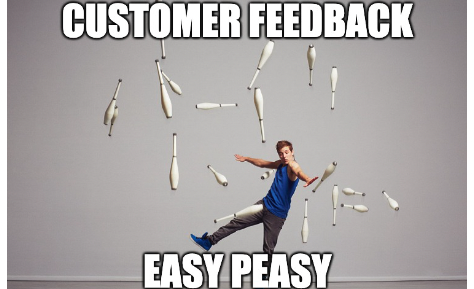
When you're selling a B2B SaaS product to another business, it's important to get feedback on that product. After all, they're the ones who will be using it in their operations! With customer feedback, you can make changes to your product to meet the needs and wants of customers.
PMs love feedback! Customer feedback assists product managers in making meaningful incremental changes. This frees up product managers' time so they can focus more on the long-term goal or significant features. Feedback might also provide PMs with innovative features.
Customers too love to give feedback because it will make their job easier if some of the features or bugs they have faced are addressed.
In this guide, we'll talk about how to get feedback on your B2B products.
Here are some traditional ways of collection feedback.
Try the ultimate feedback collection tool for free
![]() No credit card required. No-code and 1 minute setup.
No credit card required. No-code and 1 minute setup.
Send a survey after your customers had a chance to use your product
Asking for feedback from your customers is always a good idea, but timing is everything.
If you survey people too soon after they've used your product, they may not have had enough time to form a clear opinion.
On the other hand, if you wait too long, they may have forgotten all about their experience.
That's why it's generally best to send an online survey within a few days of using your product. This way, people will still be fresh in their minds and can give you more accurate feedback. Plus, surveys are more convenient to fill out online, so you're more likely to get responses.
So next time you're looking for customer feedback, make sure to survey them soon after they've used your product.
One problem with surveys is, you can get feedback once or twice. But your customers will always have some feedback on your product.
Contact customers individually to get feedback about their experience
Instead of emailing or messaging customers, meet them in person or on a Zoom call and ask for feedback. It's also a great way to connect with your customer base that may be feeling overlooked by other means.
In-person meetings provide an excellent chance to branch out of a limited number of inquiries and have a wide-open discussion.
Seeking advice from those who are already satisfied will help improve any company’s product as well as build new relationships which could lead to more sales down the line.
There are a few issues with this channel:
- A lot of time goes into setting up the meetings.
- It may be difficult to determine how many other customers have the same problem once you've heard everyone's thoughts. Should you address these issues?
- If you do not address them, your customers might think it is not worth their time to spend 30-40 minutes next time.
Monitor social media channels for comments and questions from customers
In today's digital age, social media plays a key role in the way businesses interact with their customers. Platforms such as Facebook, Twitter, and Instagram provide a direct channel for customers to share their feedback, both positive and negative. Closely monitor social media channels for comments and questions from customers.
One of the major drawbacks to using social media as the primary channel for feedback is that things might go unnoticed. You'll need someone to keep an eye on it, as well as a tool to follow the comments.
Monitor customer support tickets regularly
As a product manager, it's important to regularly monitor support tickets for feedback from customers. This feedback can be essential in identifying new feature requests and issues that customers are facing.
However, using this approach as the only way to collect feedback from your customers is impractical.
Systems for ticketing aren't designed to simply provide product-specific feedback. They'll be jam-packed with a variety of support/operations tickets Finding product-specific feedback will be like looking for a needle in a haystack.
It is hard for customers to provide feature requests or raise issues by talking to customer support staff. In the worst-case scenario customers will have a lot of feedback but just don't know how to provide the feedback.
The ultimate approach: Use a dedicated feedback collection tool.
As we saw above, sending surveys, monitoring social media channels, monitoring ticketing systems, or face-to-face meetings are some ways to get feedback on your B2B SaaS product. But they have serious limitations. They are all great solutions to other problems but they do not suitable for product feedback.
The best solution for getting feedback on B2B SaaS products is to use a dedicated customer feedback management tool like prodroll.
Advantages of using prodroll for product managers:
- Get continuous feedback on your product 24x7, 365 days. That's how good your feedback collection mechanism should be.
- Prioritize the most voted feature. Take the guesswork out of the prioritization and just focus on product feedback.
- Publicly share what items will be prioritized and what will be delayed. Customers will appreciate the transparency.
- Task your engineering team to build only those features that your customers will use. Save a ton of engineering time by not building features out of gut-feeling.
Advantages of using prodroll for customers:
- Your customers will know that there is one place for all feature requests and issues. More significantly, they'll feel as if their voice is being taken into account.
- Customers gets an option to see and vote feedback given by other customers. This way your customers co-create the product with you.
- Customers can track the status of their requests. Customers will be able to understand why some of their requests will be delayed/not-implemented if they see others may not be interested in the feature.
Conclusion
While product managers love customer feedback and customers also love to give feedback on products, the traditional feedback loops like emails, ticketing systems, social media, or surveys are not practical for continuous product feedback.
Try the ultimate feedback collection tool for free
![]() No credit card required. No-code and 1 minute setup.
No credit card required. No-code and 1 minute setup.
